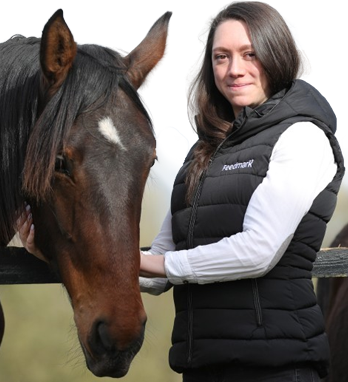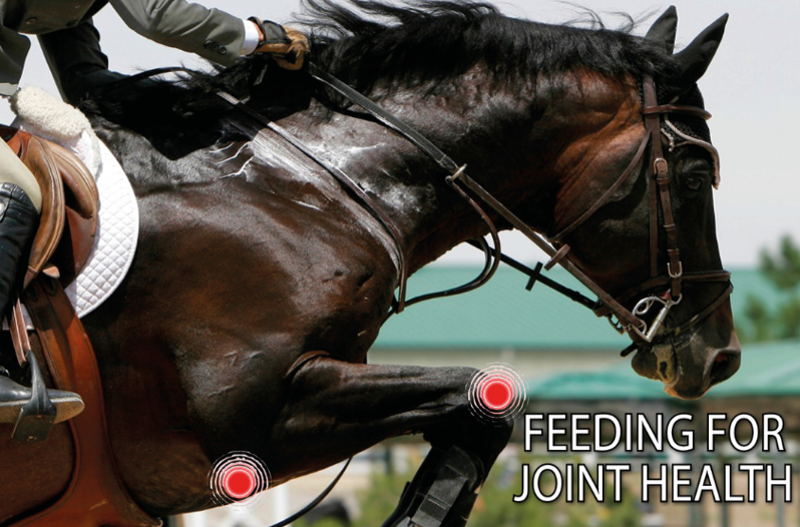Introduction
Whether your horse is at the peak of their performance, has sustained an injury or is growing older, horse joint supplements are hugely popular among horse owners for supporting mobility and flexibility.
Everyday wear and tear along with what we ask our horses to do when performing, i.e., jumping and landing or extension movements, puts pressure on their joints and increases the risk of degenerative joint issues.
Once thought to only affect the older horse, osteoarthritis (OA), also known as Degenerative Joint Disease (DJD), is the most common cause of poor performance in horses and is thought to contribute to 60% of lameness issues. OA is a progressive disease and often represents the end stage of other joint problems such as synovitis, capsulitis and osteochondrosis dissecans.
How do joints work?
Joints are where bones meet and allow the horse to move gracefully and provide for fluid movement and dexterity. Horses have rather small joints in comparison to the size of their bodies and this increases the pressure through the joints making them much more prone to injury and degradation.
Synovial joints are the most common type of joint in the body and are identified by the presence of synovial fluid within the joint capsule. Synovial joints are responsible for a huge range of movement and the two types of joints that are mainly responsible are hinge joints and ball and socket joints. Hinge joints include the fetlock, pastern and elbow and examples of ball and socket joints include the hip and shoulder.
Synovial fluid lubricates the joint allowing for free movement and is secreted by the synovial membrane, a thin layer which lines the inner surface of the joint capsule. In synovial joints the ends of the bones have a layer of cartilage which aids in cushioning the joint and prevents friction between the ends of the bone. Cartilage contains a very high level of water and when pressure is applied in a joint, this water is squeezed out to aid joint fluidity. When the pressure decreases, the water is absorbed back into the cartilage.
The bones of a joint are connected by ligaments, which are strong bands of fibrous connective tissue. Ligaments strengthen and support the joint by anchoring the bones together and limiting the range of movement to prevent excessive and abnormal joint movements.
Additional support is provided to joints via muscles, which are connected to bones through tendons – dense connective tissue structures. Muscles and tendons support joints through resisting forces and offer support to weaker ligaments in certain joint structures.
What damages joints?
The main cause of damage to joints is trauma either via repetitive forces or from a one-off force. Repetitive concussive forces to joints are the most common cause of joint issues as this leads to cartilage degradation and synovial membrane irritation. Through this process an inflammatory response is initiated by the body to repair the damage. However, if the inflammatory cycle in a joint escalates, the repair process cannot keep up and this is when arthritic changes occur.
It is important to note that inflammation is a normal part of joint function. When pressure is placed upon joints during exercise, an inflammatory response is triggered to protect the joint from trauma. When this inflammatory process escalates this is when joint remodelling occurs through overcompensation of the body to manage the degradation and repair process.
The effect of trauma on the joint initiates the ‘arthritis cycle’ which eventually leads to continual degradation of the joint, ultimately ending in joint failure and frequent lameness. This deteriorating cycle undergoes multiple processes, three of which include:
· Blood vessel blockages – leading to cartilage degradation through poor nutrition to the joint.
· Joint fluid failure – inflammation reduces the quality and production of joint fluid.
· Protein breakdown – enzymes breakdown key joint proteins, destroying cartilage.
Breaking this cycle, through managing inflammation is key to managing a horse’s comfort and longevity through promoting a healthy joint environment and supporting performance.
Supporting joint health
Whilst inflammation is an important part of the repair process, reducing unnecessary inflammation is important for the longevity of joint health.
Feeding joint nutraceuticals can manage the joint environment and support healthy joint structures leading to improved comfort, consistent performance and a reduction in lameness. Feeding four key nutrients will protect and support joint function.
GLUCOSAMINE1,2,3,4 delays the breakdown of and repairs damaged cartilage. This nutrient is important in the creation of glycosaminoglycans and glycoproteins which are essential for your horses’ ligaments, tendons, cartilage, and synovial fluid.
CHONDROITEX® consists of freshwater microalgae combined with HA. This is a vegetarian alternative to chondroitin, making it suitable for a herbivorous diet. The algae reduce inflammation, supporting your horse's joint health in both the short and long term.
METHYL SULFONYL METHANE (MSM)5 provides sulphur which is important for building collagen. MSM has a moderate effect on improving joint pain and swelling due to anti-inflammatory and antioxidant effects and when combined with Glucosamine this result is greater.
HYALURONIC ACID6 lubricates joints and reduces inflammation. It also helps to increase the density of the Synovial fluid in the joint capsule.
Finding the best joint supplement
Not all joint supplements are equal and knowing what is included will help you to manage your horse’s joint health effectively. Ensure that you feed a joint supplement which contains all four of these joint nutrients at high levels.
Best-Flex HA® is the best horse joint supplement ever formulated to support your horse’s joint health and mobility. It offers the highest declared levels of the four proven joint nutrients to support flexibility and suppleness. Best-Flex HA® also contains Boswellia to help soothe active or tired joints, Omega-3 fatty acids to maintain supple joints and the antioxidant Vitamin C that helps to neutralise free radicals.
The Best-Flex HA® daily feeding rate (for a 500kg horse) contains: 17000mg Glucosamine, 21000mg Chondroitex®, 17000mg MSM, 1100mg Hyaluronic acid, 11000mg Vitamin C, 7000mg Omega-3 and 12,000mg Boswellia.
Summary
Best-Flex HA® is probably the best horse joint supplement ever formulated to support your horse’s joint health and mobility. It contains the highest levels of the proven joint nutrients Glucosamine hydrochloride, Chondroitex®, MSM and Hyaluronic acid (HA) at optimum levels to support flexibility and suppleness. Best-Flex HA® also contains Boswellia to help soothe active or tired horse joints, Omega-3 fatty acids to maintain supple horse joints and the antioxidant Vitamin C that helps to neutralise free radicals.
References
1 Dechant, J.E. and Baxter, G.M. (2007) Glucosamine and chondroitin sulphate as structure modifying agents in horses. Equine Veterinary Education 19 (2) 90-96.
2 Oke, S. Aghazadeh-Habashi, A. Wesse, J.S. Jamali, F. (2006) Evaluation of glucosamine levels in commercial equine oral supplements for joints. Equine Veterinary Journal 38 (1) 93-95
3 Forsythe, R.K. Brigden, C.V. Northrop, A.J. (2006) Double blind investigation of the effects of oral supplementation of combined glucosamine hydrochloride (GHCL) and chondroitin sulphate (CS) on stride characteristics of veteran horses. Equine Exercise Physiology 36 622-625
4 Welch, C.A. et al. (2012) Plasma concentration of glucosamine and chondroitin sulphate in horses after an oral dose. Journal of Equine Veterinary Science, 32 (1) 60-64.
5 Maranon, G. et al. (2008) The effect of methyl sulphonyl methane supplementation on biomarkers of oxidative stress in sport horses following jumping exercise. Acta Veterinaria Scandinavica. 50 (1) 45.
6 Bergin, B. et al. (2006) Oral hyaluronan gel reduces post-operative tarsocrural effusion in the yearling Thoroughbred. Equine Veterinary Journal. 38 (4) 375-378.













